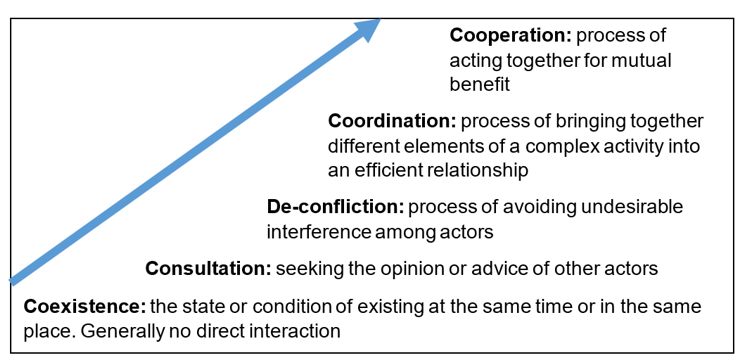I. Introduction
1.2. Civil-military interaction
NATO’s engagement in a comprehensive approach to resolve crises is facilitated through civil-military interaction (CMI), which applies to all military bodies and at all levels. Civil-military cooperation (CIMIC) functions are the main . Facilitation is done through CIMIC activities including liaison and assessments, as well as planning, coordination with other capabilities/functions involved in CMI and enabling local legitimized authorities working to resolve the crisis. CMI is defined as:
“A group of activities, founded on communication, planning and coordination, that all NATO military bodies share and conduct with international and local non-military actors, both during NATO operations and in preparation for them, thereby mutually increases the effectiveness and efficiency of their respective actions in response to .”
Thus, CMI enables processes that are necessary for building and maintaining relationships with non-military actors. It aims at expanding own knowledge networks and developing shared situational understanding of the civil environment with other relevant actors. Due to the fact that diversity of non-military actors is the reality in almost all operations, unity of effort will be hard to achieve; rather harmonization of efforts should be aimed upon to avoid negative impacts for the civil environment and for own operations.
Levels of interaction
Depending on the type of interaction, certain responsibilities will be expected by the counterpart. The levels of interaction range from coexistence to cooperation.

Possible levels of interaction between responders to a crisis.
Civil-military interaction principles
The following CMI principles are (non-exhaustive) guidelines for an effective CMI:
- Understand non-military actors and respect their autonomy in decision-making and so encouraging them to do the same. Nevertheless, aim at promoting cooperation, reciprocal information sharing and unity of purpose if circumstances allow.
- Engage, via proactive communication and on respective level, with all non-military actors involved in the operation.
- Interact with respect, knowledge of respective roles, trust and transparency and be aware of cultural aspects.
- Incorporate non-military expert advice and factors, if applicable.
- Promote local ownership and build local capacity. Prepare for transition of non-military tasks as early as possible.
- Ensure internal NATO military coherence and consistent NATO messaging in interacting with non-military actors.
- Operate within the framework of the NATO mission, responsibilities, authorities and legal obligations.
- 3
For the definition of CIMIC Allied Joint Publication (AJP) 3.19 dated 09 Nov. 2018. For further read, see Chapter 2.
- 4
AJP-3.19.
